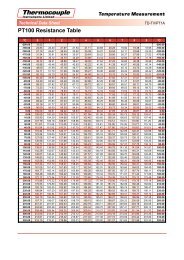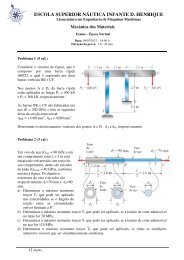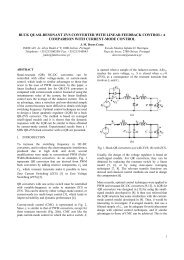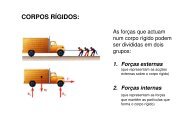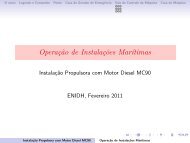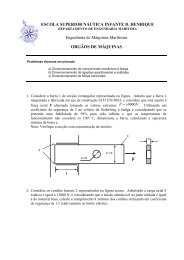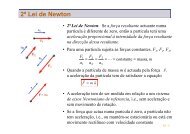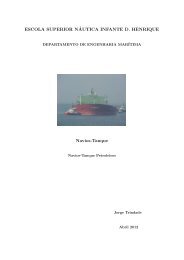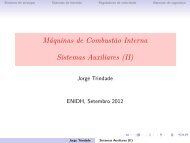Textos de Apoio (pdf)
Textos de Apoio (pdf)
Textos de Apoio (pdf)
You also want an ePaper? Increase the reach of your titles
YUMPU automatically turns print PDFs into web optimized ePapers that Google loves.
Indication of a ship’s size<br />
Displacement and <strong>de</strong>adweight<br />
When a ship in loa<strong>de</strong>d condition floats at<br />
an arbitrary water line, its displacement is<br />
equal to the relevant mass of water displaced<br />
by the ship. Displacement is thus<br />
equal to the total weight, all told, of the<br />
relevant loa<strong>de</strong>d ship, normally in seawater<br />
with a mass <strong>de</strong>nsity of 1.025 t/m 3 .<br />
A M<br />
D<br />
Displacement comprises the ship’s<br />
light weight and its <strong>de</strong>adweight, where<br />
the <strong>de</strong>adweight is equal to the ship’s<br />
loa<strong>de</strong>d capacity, including bunkers and<br />
other supplies necessary for the ship’s<br />
propulsion. The <strong>de</strong>adweight at any time<br />
thus represents the difference between<br />
the actual displacement and the ship’s<br />
light weight, all given in tons:<br />
<strong>de</strong>adweight = displacement – light weight.<br />
Inci<strong>de</strong>ntally, the word “ton” does not<br />
always express the same amount of<br />
weight. Besi<strong>de</strong>s the metric ton (1,000<br />
kg), there is the English ton (1,016 kg),<br />
which is also called the “long ton”. A<br />
“short ton” is approx. 907 kg.<br />
The light weight of a ship is not normally<br />
used to indicate the size of a ship,<br />
whereas the <strong>de</strong>adweight tonnage<br />
(dwt), based on the ship’s loading capacity,<br />
including fuel and lube oils etc.<br />
for operation of the ship, measured in<br />
tons at scantling draught, often is.<br />
Sometimes, the <strong>de</strong>adweight tonnage<br />
may also refer to the <strong>de</strong>sign draught of<br />
the ship but, if so, this will be mentioned.<br />
Table 2 indicates the rule-of-thumb relationship<br />
between the ship’s displacement,<br />
<strong>de</strong>adweight tonnage (summer freeboard/<br />
scantling draught) and light weight.<br />
A ship’s displacement can also be expressed<br />
as the volume of displaced<br />
water ∇, i.e. in m 3 .<br />
Gross register tons<br />
Without going into <strong>de</strong>tail, it should be<br />
mentioned that there are also such<br />
measurements as Gross Register Tons<br />
(GRT), and Net Register Tons (NRT)<br />
where 1 register ton = 100 English cubic<br />
feet, or 2.83 m 3 .<br />
D A<br />
B WL<br />
D F<br />
Fig. 2: Hull dimensions<br />
Ship type<br />
Tanker and<br />
Bulk carrier<br />
Length between perpendiculars: LPP<br />
Length on waterline:<br />
LWL<br />
Length o verall: LOA<br />
Breadth on waterline:<br />
BWL<br />
Draught: D = 1/2 (D F+D A)<br />
Midship section area:<br />
A<br />
dwt/light<br />
weight ratio<br />
These measurements express the size<br />
of the internal volume of the ship in accordance<br />
with the given rules for such<br />
measurements, and are extensively<br />
used for calculating harbour and canal<br />
dues/charges.<br />
Description of hull forms<br />
Displ./dwt<br />
ratio<br />
6 1.17<br />
Container ship 2.5-3.0 1.33-1.4<br />
Table 2: Examples of relationship between displacement,<br />
<strong>de</strong>adweight tonnage and light weight<br />
It is evi<strong>de</strong>nt that the part of the ship<br />
which is of significance for its propulsion<br />
L<br />
L<br />
L<br />
PP<br />
WL<br />
OA<br />
m<br />
is the part of the ship’s hull which is<br />
un<strong>de</strong>r the water line. The dimensions<br />
below <strong>de</strong>scribing the hull form refer<br />
to the <strong>de</strong>sign draught, which is less<br />
than, or equal to, the scantling<br />
draught. The choice of the <strong>de</strong>sign<br />
draught <strong>de</strong>pends on the <strong>de</strong>gree of<br />
load, i.e. whether, in service, the ship<br />
will be lightly or heavily loa<strong>de</strong>d. Generally,<br />
the most frequently occurring<br />
draught between the fully-loa<strong>de</strong>d and<br />
the ballast draught is used.<br />
Ship’s lengths L OA<br />
, L WL<br />
, and L PP<br />
The overall length of the ship L OA<br />
is<br />
normally of no consequence when<br />
calculating the hull’s water resistance.<br />
The factors used are the length of the<br />
waterline L WL<br />
and the so-called length<br />
between perpendiculars L PP<br />
. The dimensions<br />
referred to are shown in<br />
Fig. 2.<br />
5


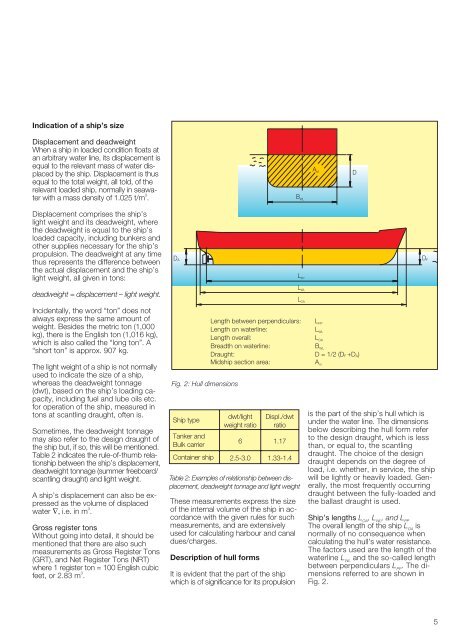
![Conceitos transmissao de dados .Sinais[.pdf]](https://img.yumpu.com/50982145/1/190x146/conceitos-transmissao-de-dados-sinaispdf.jpg?quality=85)
![Packages e interfaces[.pdf]](https://img.yumpu.com/50629553/1/190x134/packages-e-interfacespdf.jpg?quality=85)
